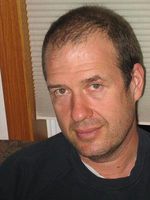John Balwit: Difference between revisions
From Santa Fe Institute Events Wiki
No edit summary |
No edit summary |
||
| Line 3: | Line 3: | ||
[[Image:balwit.jpg|150px|{border}]]<br> | [[Image:balwit.jpg|150px|{border}]]<br> | ||
I am interested, in the evolution of modularity and hierarchy in various systems. I hoping to understanding and model the mechanisms that support what John Maynard Smith calls “transitions” in evolution. I have been considering game theory, Reconstructability Analysis, cellular automata, genetic algorithms, information theory and machine learning techniques as tools to support my investigations. Ultimately, I am hopeful of developing models and formalisms that might offer insight into the mechanisms responsible for novel structures and subsystems that emerge within natural or artificial systems. | |||
I have a second set of research interests that have grown out of my exposure to the various techniques that are taught and used in the Systems Science department and complexity science, generally. These research interests tie into my decades long involvement with education and educational research. As a former high school physics and biology teacher I have a deep commitment to understanding the nature of effective science education. I have found great personal value in the use of modeling and simulation tools (specifically agent based modeling, genetic algorithms and other computational methods). In recent years, I have become increasingly interested in offering these tools to K-12 and undergraduate teachers and students. I currently work with the Santa Fe Institute learning lab offering professional development to K-12 science teachers. Our curriculum teaches science and computer science as students create agent based models of epidemics, chemical reactions and ecosystems. | |||
Latest revision as of 23:05, 15 June 2014
| Complex Systems Summer School 2014 |
I am interested, in the evolution of modularity and hierarchy in various systems. I hoping to understanding and model the mechanisms that support what John Maynard Smith calls “transitions” in evolution. I have been considering game theory, Reconstructability Analysis, cellular automata, genetic algorithms, information theory and machine learning techniques as tools to support my investigations. Ultimately, I am hopeful of developing models and formalisms that might offer insight into the mechanisms responsible for novel structures and subsystems that emerge within natural or artificial systems.
I have a second set of research interests that have grown out of my exposure to the various techniques that are taught and used in the Systems Science department and complexity science, generally. These research interests tie into my decades long involvement with education and educational research. As a former high school physics and biology teacher I have a deep commitment to understanding the nature of effective science education. I have found great personal value in the use of modeling and simulation tools (specifically agent based modeling, genetic algorithms and other computational methods). In recent years, I have become increasingly interested in offering these tools to K-12 and undergraduate teachers and students. I currently work with the Santa Fe Institute learning lab offering professional development to K-12 science teachers. Our curriculum teaches science and computer science as students create agent based models of epidemics, chemical reactions and ecosystems.

